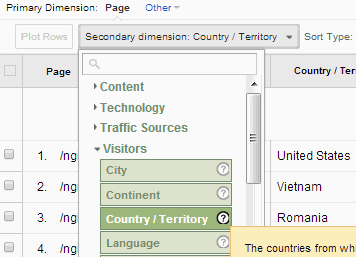Secondary Dimension in Google Analytics: Ideal Practices and Tips
Secondary Dimension in Google Analytics: Ideal Practices and Tips
Blog Article
Transform Your Analytics Method With Second Measurement in Google Analytics
Discovering the capacity of second measurements in Google Analytics opens up a world of possibilities for services seeking to elevate their logical strategy. By incorporating second measurements into information evaluation, a brand-new layer of insights arises, clarifying detailed individual habits and interactions. This innovative degree of examination not only fine-tunes advertising and marketing techniques however also deciphers concealed chances for optimization and development. The critical application of secondary measurements holds the vital to unlocking a bonanza of vital info that can transform exactly how organizations act and translate upon their data.
Recognizing Second Measurements in Google Analytics
Secondary measurements in Google Analytics give additional context to primary information by allowing customers to examine metrics throughout a 2nd dimension, providing much deeper understandings right into individual habits and interactions on a site. Secondary Dimension in Google Analytics. While key dimensions provide fundamental data factors such as pageviews, bounce price, and session period, secondary dimensions offer an even more detailed sight by segmenting the key data additionally. This division allows customers to evaluate metrics in mix with an additional measurement, such as website traffic sources, demographics, or individual actions
Benefits of Utilizing Secondary Dimensions
Making use of second measurements in Google Analytics provides a calculated benefit by improving the deepness of evaluation and offering a more thorough understanding of user communications and actions on a site. By incorporating second measurements, analysts can gain valuable insights right into the efficiency of certain sections or variables within their information. This allows a much more thorough examination of individual habits past surface-level metrics, permitting a much deeper expedition of the elements affecting individual interaction and conversions.

Exactly How to Apply Secondary Measurements
When integrating additional measurements in Google Analytics, one vital action is to pick the pertinent metrics and measurements to improve the evaluation process. Clicking on this button will open up a drop-down menu listing various measurements that can be included to your key dimension for much deeper insights.
After selecting the proper second measurement, such as 'Source/Medium' or 'Tool Category,' Google Analytics will certainly show the information in a much more in-depth style, allowing you to cross-analyze various elements of user behavior. Bear in mind to try out different combinations of additional and primary dimensions to reveal useful patterns and patterns that can inform your advertising and marketing techniques. By implementing recommended you read secondary measurements attentively, you can get a more extensive understanding of your website or application efficiency and make data-driven decisions to enhance your digital presence.
Studying Data With Secondary Measurements
Improve your data evaluation in Google Analytics by including secondary dimensions to dive much deeper right into user actions patterns and enhance your electronic marketing methods effectively - Secondary Dimension in Google Analytics. By adding secondary measurements to your primary data, you can acquire beneficial understandings that can help you make informed choices concerning your internet site or application efficiency
Analyzing information with secondary dimensions allows you to address segment your primary data further, offering an extra comprehensive view of individual interactions. Combining the key measurement of 'source/medium' with a second measurement like 'landing page' can expose which certain pages are driving website traffic from various sources. This information can be critical in refining your material technique or optimizing your marketing campaign to increase conversions.
Furthermore, making use of second measurements enables you to recognize relationships between different metrics, helping you understand the impact of different elements on individual actions. Whether it's assessing demographics together with user involvement metrics or tool classifications with conversion prices, second dimensions empower you to discover concealed patterns and patterns that can direct your advertising efforts.
Maximizing Efficiency With Secondary Dimensions
To boost the effectiveness of data analysis and decision-making in Google Analytics, including additional dimensions is vital to enhancing efficiency metrics and getting deeper insights right into individual actions patterns. By using second dimensions, analysts can delve past surface-level information and reveal useful connections that might or else go undetected. This optimization strategy enables businesses to tailor their marketing efforts more effectively, recognize locations for improvement in website usability, and boost total individual experience.
Secondary measurements use a more comprehensive sight of user interactions by offering additional context to main information metrics. As an example, pairing the key dimension of 'landing page' with a second dimension like 'gadget group' can disclose whether particular devices are more probable to drive engagement on details touchdown pages. This insight can notify responsive layout improvements or targeted advertising techniques to improve efficiency.

Conclusion
To conclude, the assimilation of additional Get More Info dimensions in Google Analytics supplies companies with a powerful device to enhance their analytics technique. Secondary Dimension in Google Analytics. By delving deeper into customer behavior and interactions, marketing experts can discover valuable understandings that can drive performance optimization and enhance the overall individual experience. Leveraging additional dimensions enables a more detailed evaluation of data, resulting in even more educated decision-making and tailored advertising efforts
Secondary measurements in Google Analytics give extra context to primary information by permitting customers to analyze metrics across a second dimension, supplying deeper insights right into individual behavior and communications on an internet site. While main measurements provide fundamental information points such as pageviews, bounce price, and session period, additional dimensions offer an even more in-depth sight by segmenting the primary information better.One of the key benefits of utilizing secondary measurements is the ability to discover connections and patterns that may not be quickly apparent when evaluating data with primary dimensions alone.When including additional dimensions in Google Analytics, one crucial step is to choose the relevant metrics and measurements to improve the evaluation procedure. Coupling the primary measurement of 'landing page' with a second measurement like 'gadget classification' can expose whether specific tools are extra likely to drive involvement on details landing pages.
Report this page